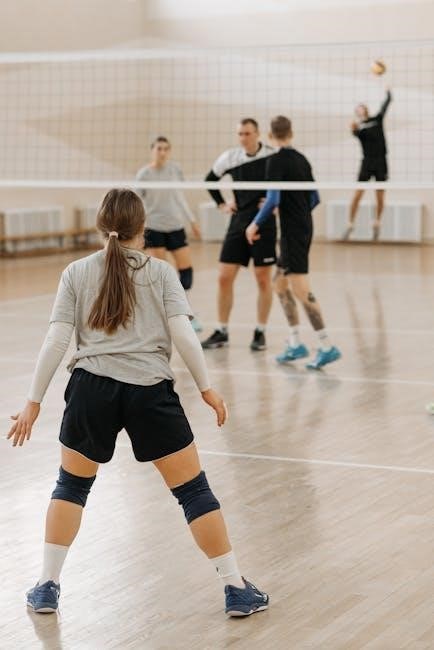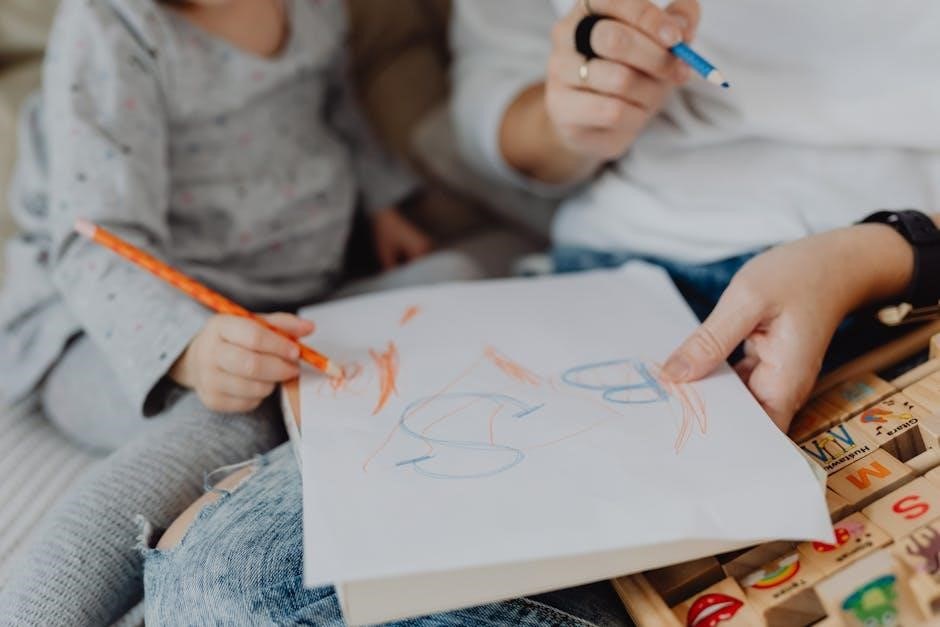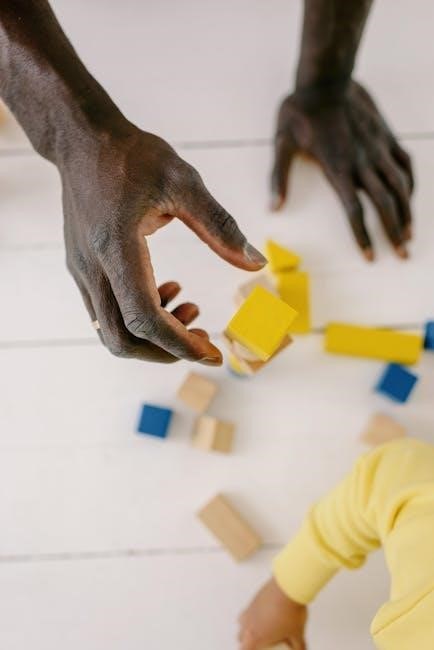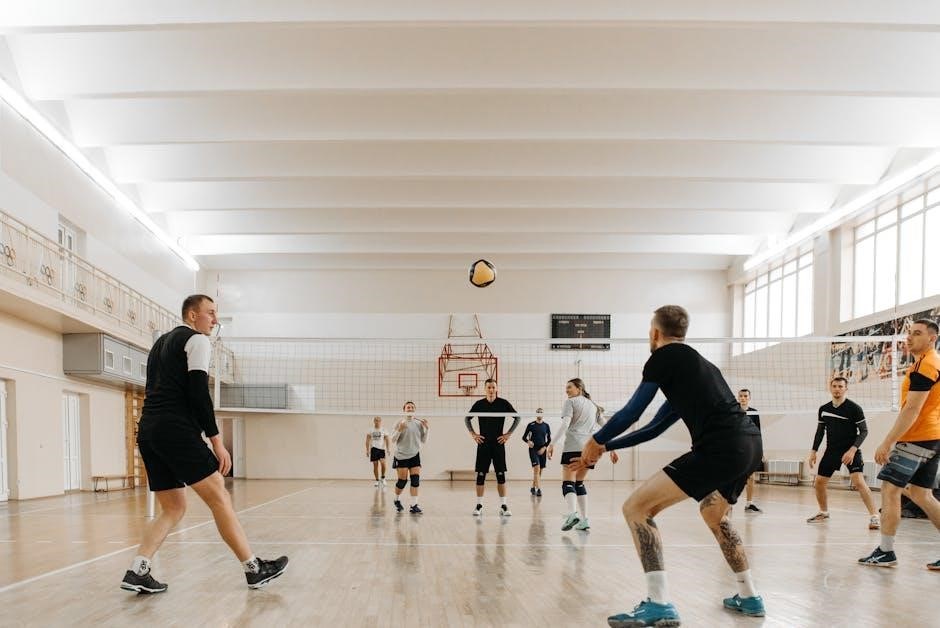Fine motor coordination involves precise movements of small muscles, essential for dexterity and accuracy in daily tasks. It enhances independence and overall functional abilities in adults.
1.1 What Are Fine Motor Skills?
Fine motor skills refer to the precise movements of small muscle groups, particularly in the hands and fingers, enabling tasks like writing, buttoning, or using utensils. These skills require coordination and dexterity, involving thumb and finger movements. Activities such as picking up small objects or using chopsticks exemplify fine motor functions. Developing these skills is crucial for performing daily tasks efficiently, as they enhance independence and overall quality of life. Strengthening fine motor abilities through targeted exercises can improve dexterity, making everyday activities easier and more manageable for adults.
1.2 Importance of Fine Motor Coordination for Adults
Fine motor coordination is vital for adults, enhancing independence in daily tasks like cooking, dressing, and using tools. It improves dexterity, making activities such as writing, buttoning, or handling small objects easier. Strong fine motor skills boost confidence and reduce the risk of injuries from accidents caused by poor coordination. Additionally, fine motor exercises can delay age-related motor decline, maintaining functional abilities and quality of life. Engaging in activities that strengthen these skills supports overall physical and cognitive well-being, ensuring adults remain active and self-sufficient in their daily routines and hobbies.
Fine Motor Coordination Activities for Adults
Explore effective fine motor coordination activities tailored for adults, enhancing dexterity and strength through targeted exercises and daily tasks to improve functionality and independence.
2.1 Theraband Exercises and Squeezing Balls
Theraband exercises and squeezing balls are excellent tools for improving fine motor coordination in adults. These activities target hand and finger strength, enhancing dexterity and precision. Using a Theraband involves stretching and resisting, which helps build resistance and control. Squeezing balls, such as stress balls or hand grips, focuses on finger and thumb muscles, improving grip strength and coordination. Both methods are simple yet effective for strengthening hand muscles and enhancing motor function. They can be incorporated into daily routines to improve overall hand dexterity and fine motor skills, making them ideal for adults seeking to refine their motor abilities through targeted exercises.
2.2 Picking Up Small Objects (Buttons, Marbles, Coins)
Picking up small objects like buttons, marbles, or coins is a simple yet effective fine motor coordination activity for adults. This exercise enhances dexterity by requiring precise finger movements and hand-eye coordination. Adults can practice by spreading the objects on a flat surface and picking them up one by one, placing them into a container. Using tweezers or chopsticks adds an extra challenge, further refining finger control. This activity is ideal for improving pincer grasp and fine motor precision, making it a practical and engaging way to strengthen hand function in daily life. Regular practice can lead to noticeable improvements in dexterity and coordination.
2.3 Finger Exercises and Pencil Control
Finger exercises and pencil control activities are excellent for improving fine motor coordination in adults. Simple exercises like thumb-to-finger touches, finger spreads, and finger bends strengthen hand muscles and enhance dexterity. Pencil control tasks, such as tracing lines, drawing shapes, or completing mazes, refine precision and accuracy. Using worksheet exercises or guided patterns helps adults refine their ability to grip and maneuver writing tools effectively. These activities are particularly beneficial for improving handwriting and fine motor precision, making them ideal for both therapeutic and everyday skill enhancement. Regular practice can lead to improved performance in tasks requiring detailed hand movements.

Daily Tasks as Fine Motor Exercises
Daily tasks like cooking, using utensils, and buttoning shirts naturally improve fine motor coordination. These activities enhance hand dexterity and precision, fostering independence in everyday life.
3.1 Using Utensils, Zippers, and Buttons
Using utensils, zippers, and buttons are everyday tasks that naturally enhance fine motor coordination. Activities like holding chopsticks, managing zippers, or buttoning shirts require precise hand movements. These tasks strengthen finger dexterity and hand-eye coordination, making them ideal for improving motor skills. Incorporating these exercises into daily routines can help adults maintain or enhance their fine motor abilities. For example, using chopsticks to pick up small objects or practicing buttoning shirts with one hand can challenge and refine motor control. Such activities are practical and effective for improving coordination in a real-world context.
3.2 Cooking, Baking, and Art Activities
Cooking, baking, and art activities are engaging ways to improve fine motor coordination. Tasks like measuring ingredients, mixing batter, or shaping dough require precise hand movements. Similarly, painting, drawing, or crafting with tools like brushes or scissors enhance dexterity and control. These activities not only strengthen motor skills but also provide a sense of accomplishment; For adults, these tasks can be tailored to varying skill levels, making them accessible and effective. Incorporating creative activities into daily routines offers a fun and functional way to refine fine motor abilities while enjoying the process of creating something meaningful.
3.3 Playing Musical Instruments
Playing musical instruments is an excellent way to enhance fine motor coordination in adults. Activities like pressing piano keys, strumming guitar strings, or drawing a bow across a violin require precise finger movements and hand dexterity. These actions strengthen the muscles in the fingers and hands, improving coordination and control. Additionally, the repetitive practice of musical techniques helps develop muscle memory, further refining motor skills. Engaging in music also provides a creative outlet, making it an enjoyable and motivating way to improve fine motor abilities while fostering emotional well-being and cognitive function.

Occupational Therapy-Based Activities
Occupational therapy-based activities focus on enhancing fine motor skills through targeted exercises, such as arm strengthening and card games, improving dexterity and hand-eye coordination effectively.
4.1 Arm and Hand Strengthening Exercises

Arm and hand strengthening exercises are foundational for improving fine motor coordination. Sit in a supportive chair with feet flat on the floor, hands clasped together, and press palms firmly. Finger exercises, such as touching the thumb to each fingertip, enhance dexterity. Squeezing a small ball or using a Theraband strengthens hand muscles. Activities like picking up small objects or using chopsticks improve precision and grip. These exercises not only boost coordination but also make daily tasks easier. Consistency is key to achieving noticeable improvements in motor function and overall hand-eye coordination.
- Clasp hands and press palms together.
- Touch thumb to each fingertip.
- Squeeze a small ball or Theraband.
- Pick up small objects or use chopsticks.
4.2 Card Games and Puzzles
Card games and puzzles are engaging activities that improve fine motor coordination. Shuffling and dealing cards enhances hand dexterity, while puzzles like jigsaw or shape sorters require precise movements. These activities strengthen finger control and hand-eye coordination, making them ideal for therapy. They also provide mental stimulation, combining cognitive and motor skills development. Adults can benefit from these tasks by improving their ability to manipulate small objects and perform daily activities with greater precision.
- Shuffling and dealing cards.
- Completing jigsaw puzzles.
- Using shape sorters.
- Engaging in activities that combine cognitive and motor skills.
The Role of Physical Activity in Motor Function
Physical activity enhances motor function by improving coordination and strength. Regular exercise supports cognitive-motor dual tasks and reciprocal aiming, boosting overall dexterity and functional abilities in adults.
5.1 Cognitive-Motor Dual Tasks
Cognitive-motor dual tasks combine physical and mental activities, enhancing coordination and balance. Examples include walking while talking or carrying objects. These tasks improve motor function by challenging the brain to multitask, boosting neural connections. Regular practice reduces fall risks and enhances daily functioning, especially for older adults. Activities like using chopsticks or playing musical instruments also fall under this category, promoting dexterity and focus.
5.2 Reciprocal Aiming Tasks
Reciprocal aiming tasks involve using both hands or limbs to perform coordinated movements, enhancing fine motor precision and dexterity. Activities like using chopsticks to pick up small objects or transferring marbles between containers improve hand-eye coordination and balance. These tasks also strengthen neural pathways, boosting motor function and cognitive abilities. For example, rolling a pencil between fingers or twirling a pen like a baton challenges coordination and control. Regular practice of such tasks can enhance daily functioning and reduce motor skill decline, particularly in older adults. Incorporating these exercises into routines promotes overall motor efficiency and independence.
